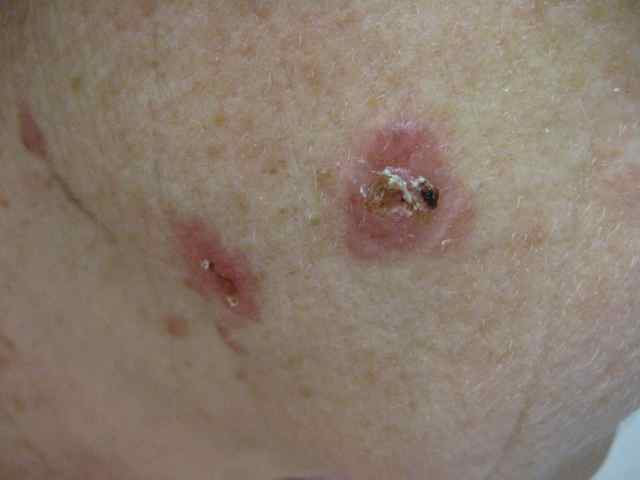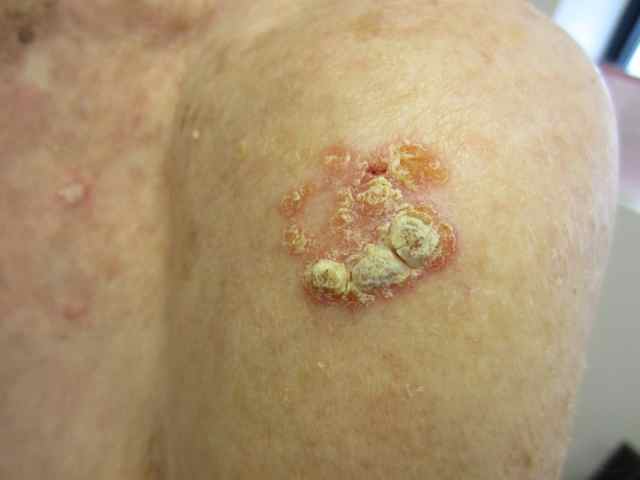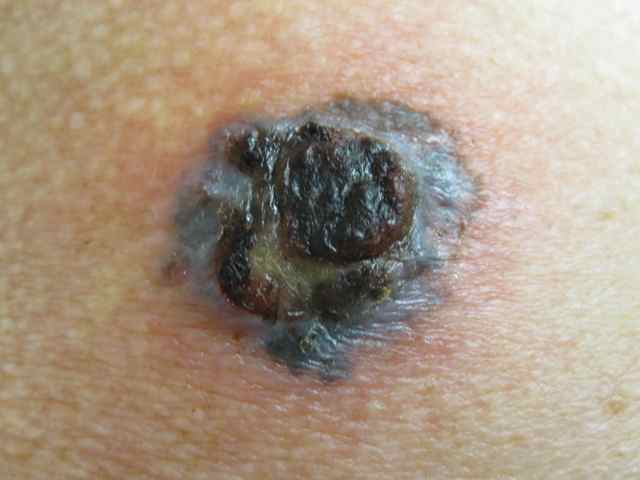Skin cancer is the most prevalent of all types of human cancers. Fair-skinned people who sunburn easily are at a particularly high risk for developing skin cancer.
Actinic Keratoses (AK): The Earliest Skin Cancer

Actinic keratoses are considered the earliest stage in the development of skin cancer. They are small red rough spots most commonly found on the face, ears, neck, lower arms, and back of the hands in fair-skinned individuals who have had significant sun exposure; they can sometimes be sensitive or sore. Actinic keratoses can be treated by liquid nitrogen cryotherapy (freezing), topical creams, surgery, and photodynamic laser therapy. Home therapy with creams including 5-FU (Efudex®), imiquimod (Zyclara® or Aldara®), or ingenol mebutate (Picato®) are commonly used for people with multiple or recurring lesions. Imiquimod 3.75% (Zyclara®) is a commonly used prescription cream for actinic keratoses that works by helping the immune system to fight the abnormal and rapidly dividing precancerous cells. It is applied once a day during a 6 weeks period (2 weeks used, 2 weeks break, then used again for 2 weeks) and can effectively and safely clear up actinic keratoses sun damage. Creams like Zyclara® may need to be reapplied periodically (e.g. once per year) to manage sun damage and actinic keratoses.
Basal Cell Carcinoma (BCC)

Basal cell carcinoma is the most common type of skin cancer and appears frequently on the head (especially the nose) and neck, as a small, fleshy bump or even a flat patch; the lesion can be fragile and bleed easily, or be sensitive and sore. Other parts of the body may be affected as well. Basal cell carcinomas are most frequently found in fair-skinned people and rarely occur in dark skin. It is fairly slow growing. Untreated, the cancer often will begin to bleed, crust over, heal, and repeat the cycle. This type of cancer very rarely metastasizes (spreads to other parts of the body) or kills, but it can extend below the skin to the bone and nerves, causing local damage.
There are various surgical treatment methods for basal cell carcinoma. Vismodegib (Erivedge®) is a new and novel pill medicine for patients with advanced basal cell carcinoma.
Squamous Cell Carcinoma (SCC)

Squamous cell carcinoma is the second most common skin cancer; it is primarily found in fair-skinned people and uncommonly in dark-skinned individuals. Typically located on the rim of the ear, the face, lips, and mouth, this cancer may appear as a bump, or as a red, scaly patch; lesions can be sensitive or sore. SCC can develop into large masses and become invasive. Unlike basal cell carcinoma, this form of cancer can metastasize (spread to other parts of the body); therefore, it is important to get early treatment. When found early and treated properly, the cure rate for both basal cell and squamous cell carcinomas is over 95 percent.
Malignant Melanoma (MM)

Malignant melanoma is the most deadly of all skin cancers. The death rate is declining because melanoma is usually curable when detected in its early stages and patients are seeking help sooner.
Melanoma begins in melanocytes, the skin cells that produce the dark protective pigment called melanin that makes the skin tan. Since melanoma cells usually continue to produce melanin, the cancer appears in mixed shades of tan, brown, and black although it can also be red or white. Melanoma can metastasize (spread), making treatment essential. Melanoma may appear suddenly or begin in or near a mole, or another dark spot in the skin.
It is important to know the location and appearance of the moles on the body to detect changes early. Any changing mole must be examined by a dermatologist. Early melanoma can be removed while still in the curable stage.
Excessive sun exposure, especially sunburn, is the most important preventable cause of melanoma. Light-skinned individuals are at particular risk. Heredity also plays a part. A person has an increased chance of developing melanoma if a relative or close family member has had melanoma. Atypical moles (dysplastic nevi), which may run in families, and a large number of moles, can serve as markers for people at increased risk for developing melanoma. Dark skin is not a guarantee against melanoma. People with skin of color can develop melanoma, especially on the palms, soles, under the nails, in the mouth, or on the genitalia.
Warning signs of melanoma include:
- Changes in the surface of a mole.
- Scaling, oozing, bleeding, or the appearance of a new bump.
- Spread of pigment from the border of a mole into surrounding skin.
- Change in sensation including itchiness, tenderness, or pain.
The ABCDEs of Melanoma: when to worry about moles
Asymmetry – One half doesn’t match the other half in size, shape, color, or thickness.
Border irregularity – The edges are ragged, scalloped, or poorly defined.
Color – The pigmentation is not uniform. Shades of tan, brown, and black are present. Dashes of red, white, and blue add to the mottled appearance.
Diameter – While melanomas are usually greater than 6mm in diameter (the size of a pencil eraser) when diagnosed, they can be smaller. If you notice a mole different from others, or which changes, itches, or bleeds (even if it is small), you should see a dermatologist.
Evolution – The most important alerting sign is evolution or change in moles
Treatment of Skin Cancer
If a skin biopsy reveals cancer or the lesion is a clinically (visually) obvious skin cancer, the dermatologist has an array of medical and surgical procedures as treatment, depending upon the type of cancer, its location, and the needs of the individual.
Dermatologic surgical treatments include electrodessication and curettage (ED&C) that involves alternately scraping or burning the tumor in combination with low levels of electricity, surgical excision, cryosurgery (freezing using liquid nitrogen), and Mohs micrographic surgery. Other dermatologic treatments include radiation therapy, topical chemotherapy, and most recently a new oral therapy for aggressive or large basal cell cancers.
Early Detection is the Surest Way to a Cure
Develop a regular routine to inspect your body for any skin changes. If a growth, mole, sore, or skin discoloration appears suddenly, or begins to change, see a dermatologist. It is wise to have an annual skin examination by a dermatologist, especially for adults with lots of moles, significant past sun exposure or a family or personal history of skin cancer.
The Best Defense – Sun Avoidance
Overexposure to ultraviolet light (sunlight or tanning lamps), especially if it results in sunburn and blistering, is the main cause of skin cancer. Seek shade if possible between 10am-4pm when the sun’s rays are most intense. Wear light-colored, tightly-woven, protective clothing like long sleeves and pants, a wide- brimmed hat, and sunglasses. Wear a sunscreen with both UVA & UVB protection, ideally with an SPF of 30 or more. Reapply sunscreen every 2-3 hours when in the sun and always after sweating or water exposure.
